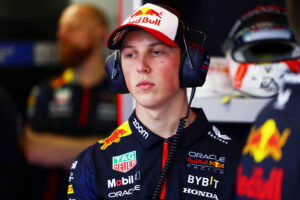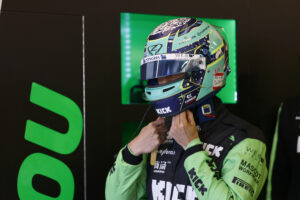Juan Manuel Fangio fondly called “El Maestro” (the Master) is Formula 1’s first superstar. Fangio is one of the greatest Formula One drivers of all time. The Argentine-born driver dominated the first decade of Formula1 racing. Fangio won five World Drivers’ Championships (WDC) in the 1950’s and set many a record which remains unchallenged to this day.
Formula 1’s First Superstar – Juan Manuel Fangio
Early Life
Fangio was born in June 1911 in the small city of Balcarce near Buenos Aires, Argentina to parents who were Italian immigrants. He was diminutive in stature and like most Argentinean boys played football. He was bowlegged and good at kicking a football around and was initially nicknamed “El Chueco” (the bowlegged one). Born into a modest family, he dropped out of school when he was thirteen years old and worked as a mechanic’s assistant. From this early work started his lifelong love of cars. This eventually led to a career in racing.
Early Racing Career
Fangio undertook compulsory two-year military service when he was twenty-one. His commanding officer recognized his driving skills and appointed him as a driver. On returning home from the army, Fangio devoted his time to rebuilding cars. In 1934, he started his racing career in stamina building cross-country marathons in a Model T Ford car that he had rebuilt. Later he raced with Chevrolet cars and won the Argentine National Championship in 1940 and 1941. During these grueling races, he fought against arch rival Oscar Galvez winning many a race over the next few years.
After a period of inactivity due to the Second World War, he resumed his racing career in 1946. In 1948, Fangio and Galvez were sponsored by the Argentine government and sent to race in Europe. Fangio won four out of six Formula 1 races he entered in 1949 with a Maserati car. The Argentinean driver, who spoke mostly Italian and very little English, astonished his European rivals with his driving skills.
The Start of his Illustrious Career in F1
Formula 1’s first World Driving Championship was organized in 1950 with a total of seven races. In the first championship, points were awarded to the top five finishers – 8, 6, 4, 3, 2 points respectively. The best four results of each driver in the seven races were taken and a driver was also awarded one point for the fastest lap.
Each team had three cars participating in the championship. In the early days of F1, a driver could take over a teammate’s car and both of them would share the points won equally, regardless of the laps driven. Team orders in F1 were born at this early stage of its history.
In 1950, Fangio drove an Alfa Romeo and finished second to teammate Giuseppe “Nino” Farina. The Argentine drove in six out of the seven races that season winning in Monaco, Belgium and France. He retired from the races in Great Britain, Switzerland and Italy (all won by Farina). The Alfa Romeo team did not participate in the Indianapolis 500 race that season. With Farina and Fangio winning the same number of races, Farina’s fourth place finish in Belgium saw him edge Fangio into second place to win Formula 1’s first ever drivers’ championship.
First World Drivers’ Title
In 1951, Fangio was crowned champion for the first time driving for the Alfa Romeo team at the ripe old age of forty. The Argentinean driver edged out Ferrari’s Alberto Ascari. The championship had expanded to eight races that year with a newly added race in Spain. Fangio again won three races that season. The second championship had the same rules as the first one.
The legend of “El Maestro” was born with his first drivers’ title. Fangio would go on to win four more titles with three other teams – Mercedes, Ferrari and Maserati. Fangio is the only driver in Formula 1 history to win championships with four different teams. Michael Schumacher, Alain Prost and Lewis Hamilton, three drivers with four WDCs, have won titles with two teams. Sebastian Vettel has won four titles with the Red Bull Racing team. Like all great champions, he had an indomitable spirit to win and could be quite ruthless in moving to the teams with the best car for the season. He would also not hesitate to take over a teammate’s car in case of a mechanical failure.
More World Drivers’ Titles
In 1952, the World championship was run under new rules and the Alfa Romeo team could not participate. Fangio suffered multiple injuries including a broken neck in a crash in a Maserati car in a non-championship race in Monza. He recovered from his injuries and returned to competitive racing the following year driving again for the Maserati team.
In 1953, he finished in second place behind the previous year’s champion and archrival, the Italian Alberto Ascari (still at Ferrari). Fangio had only one win that season in the last race in Italy.
In 1954, Fangio returned to his championship winning ways after switching to the Mercedes Silver Arrows team mid-season. He won the first two races for the Maserati team and then went on to win four of the six remaining races with Mercedes. It was a dominant performance by the Argentinean driver that season. This was followed by three more titles from 1955 to 1957.
In 1955, Fangio again won the title with the Mercedes team alongside the legendary Stirling Moss. In 1956, he moved to the Ferrari team where he won his fourth World Championship edging out the unfortunate Moss, who was now driving for Maserati. The “El Maestro” did not enjoy an easy relationship with Enzo Ferrari who was in the process of building one of the fabled teams of Formula 1 racing in the following years.
The Fifth and Final title
In 1957, Fangio won his fifth and last title after returning to Maserati. The legendary Argentine once again beat Stirling Moss, who was driving for the Vanwall team by then. Fangio’s dominance in this decade was one of the reasons the legendary British driver never won a world championship.
A win at the German Grand Prix on the Nordschleife circuit of Nurburgring in what is considered one of the greatest Formula 1 races of all time helped seal Fangio’s fifth title and his legendary status as a Formula 1 driver.
In that race, Fangio started from pole position and built a 30-second lead over his two Ferrari rivals, Peter Collins and Mike Hawthorn. The Argentine was a master strategist and had started on half a tank of fuel and also planned to have a pitstop to change tyres. After building a sizeable lead, he pitted on the thirteenth lap and had a disastrous pit stop. Fangio came out 50 seconds behind the Ferrari drivers. But after that, Fangio set one fastest lap after the other to catch his rivals.
This included one lap where he was a full eleven seconds faster than the two drivers in front of him. Eventually Fangio passed them on the penultimate lap and won the race. This championship-clinching race is often regarded as one of the greatest drives in Formula 1 and one of Fangio’s greatest wins. It was also his last win as Fangio retired after the sixth race of the 1958 season, the French Grand Prix.
The Records set by the Legendary Fangio
The five titles he won, including four consecutive titles from 1954 to 1957, stood as a record for the next 46 years. In 2003, Michael Schumacher won his sixth title which included four straight titles from 2000-2003. In 2004, Schumacher won his seventh and last title which included five consecutive championships to break another of Fangio’s records.
After over sixty years of Formula 1 racing where the season has expanded from seven races to twenty races hosted around the world, many of Fangio’s records still stand. He has the highest winning percentage of any F1 driver with 47.05% winning 24 races of 51 starts. His contemporary and rival Alberto Ascari is second on the all-time list with 40%.
Compare this with the modern greats like Schumacher with 29.74% (91 wins in 306 starts), Prost with 25.63% (51 wins from 199 starts), Senna with a winning percentage of 25.46% (41 wins in 161 starts), four-time World Champion Sebastian Vettel with 23.73% (47 wins in 198 starts) and current four-time World Champion Lewis Hamilton with 29.80% (62 wins in 208 starts). Schumacher’s performance was not helped by the unsuccessful comeback with Fangio’s old team Mercedes. But even during his first career the legendary German could not assert such total dominance over the rest of the field.
Fangio had 29 pole positions in 52 races and started on the front row an astonishing 48(!) times in all. He had 23 fastest laps in his career and no wonder the brilliance and dominance of this driver is still remembered to this day. Fangio raced in an era with no seat belts and no fire-proof race suits, when racing was hazardous and life threatening. Fangio is the oldest ever Formula 1 drivers’ champion winning his last title when he was 46 years old.
The Driving Philosophy
Fangio was a master at coaxing the maximum out of his car and finishing long and energy sapping races. Fangio’s driving was based on the principle of “not driving as fast as possible but only as swiftly as necessary.” This was a blessing for the confection of metal and rubber on whose cooperation he was reliant. After his legendary drive at the German Grand Prix he said: “I have never driven that quickly before in my life and I do not think I will ever be able to do it again.”
Life After Racing
After retiring, Fangio sold Mercedes-Benz cars in Argentina and was named the President of their Argentinean operations in 1974. His post-retirement days took a dramatic turn in 1958. Fangio was kidnapped for twenty-six hours by Fidel Castro’s rebel troops to embarrass then Cuban President Batista. But Fangio was released unharmed and spent his later years as a successful businessman. He was inducted into the International Motor Sports Hall of Fame in 1990 and eventually died in 1995 at the ripe old age of 84.
The standard this great Formula 1 driver set in the early years of Grand Prix racing was one of excellence of the highest order. To this day drivers measure themselves against his records and legendary driving skills. The “El Maestro” Juan Manuel Fangio was the first superstar of F1. The Argentine will always have a special place in the annals of Formula 1 racing.
Main Photo:
Embed from Getty Images






